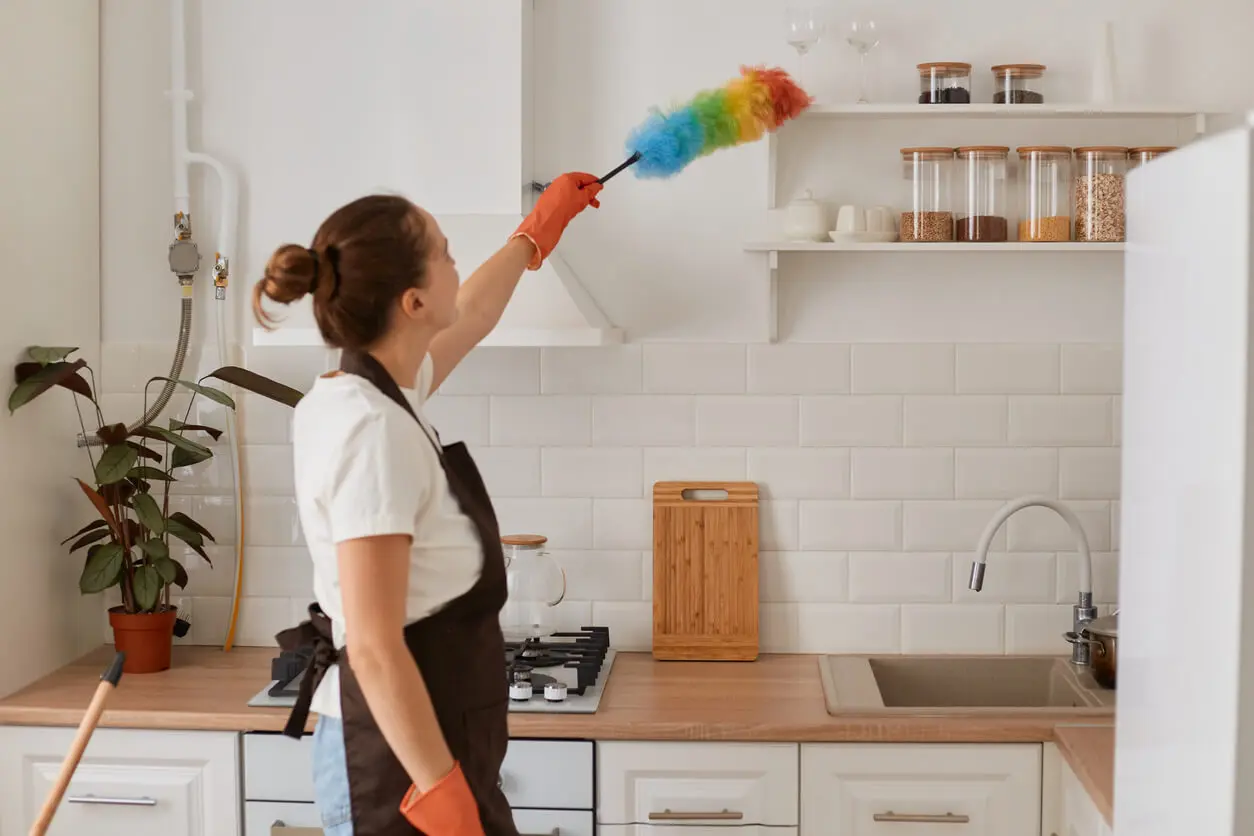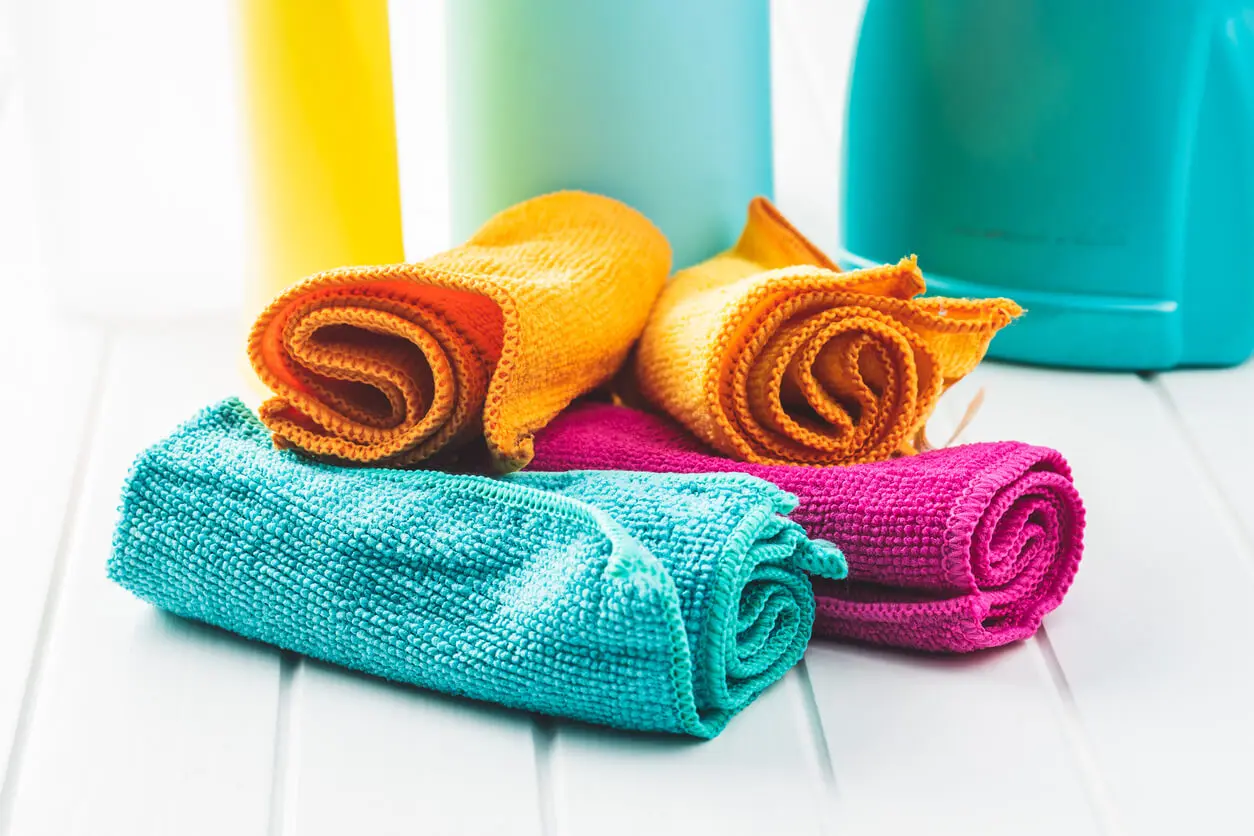Learn How to Clean and Disinfect Cleaning Tools


Reviewed and approved by the doctor Leonardo Biolatto
When was the last time you washed your cleaning towels, brushes, and other household cleaning tools? How did you do it? Cleaning and disinfecting cleaning tools is a habit that requires daily practice.
Properly maintained tools work better, last longer, and don’t accumulate germs that you then slowly and unknowingly spread around the house. There’s also the renovation scenario – i.e., the time to throw out the old and use new equipment in optimal conditions.
We’ll teach you how to clean these instruments, with the purpose of prolonging their performance and preventing health complications.
The importance of cleaning and disinfecting cleaning utensils
It’s true that household cleaning materials come into contact with cleaning substances, but this is insufficient to ensure that microorganisms do not adhere. Handling products without gloves and without complying with instrument sanitation increases the risk of illness.
As the Mayo Clinic explains, microbes are in the soil, in the air, in the water, and on any surface. By cleaning spaces regularly, you remove germs, but you don’t eliminate them completely, alleges a publication from Sant Joan de Déu Hospital.
This is what happens to the utensils you don’t sanitize. They accumulate pathogens that cause cross-contamination and disrupt health.
Such tools are thought to clump more bacteria than there are in a toilet or showerhead, for example. So, don’t put off sanitizing materials and consider immediate replacement of disposables.
If your housekeeping tools are clean, they work better and reduce the time you spend on the chores.
We show you how to clean and disinfect different cleaning tools
Hot water, washing machine, and bleach are some convenient implements in cleaning utensils. As for disinfection, it is appropriate to take into account the type of object and, from there, apply the following methods.
Cleaning and disinfecting cleaning tools: Dusters
The duster is a magnet for dust and a trigger for dust mites. Eureka Magazine on Science Education and Dissemination points out that the excrement of arachnids is a source of allergens and a trigger for respiratory problems. For its part, Medicina & Laboratorio mentions that allergic conjunctivitis, sinusitis, and otitis are related to dust mites.
For prevention, take the duster to a disused area or the yard and gently tap it so that the dust falls to the ground. Finally, vacuum up the particles.
However, to ensure total germ elimination, examine the composition of the instrument. If it’s made of synthetic fiber, clean it with a hand vacuum; feather dusters require rinsing with water, soap, and air-drying.

We think you may be interested in reading this, too: Active Oxygen: What It Is and Its Uses for Household Cleaning
Brooms and brushes
Take brooms to an open space and shake them out. Then use an old comb to get the dirt out of the bristles. It happens that, while you use them, they drag lint, hair, and other dirt.
As a disinfectant complement for brooms, mix water with a splash of detergent in a bucket, soak it for 5 minutes and rinse until no foam comes out. Some people add a touch of bleach to the formula.
A similar situation applies to brushes for cleaning furniture, curtains, and clothes. The kitchen brushes can go in the dishwasher and room brushes can be sprayed with hydrogen peroxide; all of this must be done after shaking the dirt off with a smaller brush.
Brooms and brushes should be washed with warm water because it doesn’t wear out the bristles. Always opt for rinsing instead of soaking. However, if you opt for the latter, combine water with bleach or baking soda, without forgetting to rinse afterward.
Cleaning and disinfecting cleaning tools: Mops
Although a mop is essential for shiny floors, it often picks up any kind of dirt; even the invisible one. After using this tool, throw away the soaking water and proceed to wash and dry the mop, so that it does not acquire a bad smell or harbor bacteria.
Important fact: water is the main ingredient, but it won’t do anything by itself. Add a little vinegar, which has good effects and is less risky than bleach.
The Journal of Applied Microbiology recommends acetic acid (the chemical name of the solution) for general household use, as long as the cleaning formulas are freshly prepared. Also, BMC Microbiology suggests combining vinegar with citric acid, as it provides better concentration and would be more effective.
Toilet brushes
Toilet brushes are often handled in the bathroom and require sanitizing with hot water and bleach and disinfectant products. The recommendation is to put them in a bucket with water and the amount of bleach indicated on the product label.
Leave them for half an hour. If you still notice dirt after half an hour, extend the soaking for another few minutes. Before taking it to storage, wait for it to dry.
Clean and disinfect cleaning utensils: Sponges
Kitchen sponges are a breeding ground for bacteria. In fact, the Scientific Reports shared an experiment in which these utensils showed a high diversity of bacteria; therefore, they advise replacing them every week.
A sponge attracts bacteria from food leftovers, skin, and other surfaces. Microorganisms find in these objects a humid and comfortable environment, with the nutrients they need to proliferate.
After using a sponge, use detergent to wash it, squeeze it, and hang it in the sun.
Microfiber cloths
According to the instructions on the label of the cloth, you can wash it by hand or in the washing machine. For the first alternative, dampen them separately in a paste of baking soda and water, rub them, let them sit for half an hour, and then rinse them. Warm soapy water also works.
If machine washing is used, do not introduce other pieces that do not belong to the domestic toilet. Remember that these cloths are impregnated with dirt.
It’s best to use hot water and enzymatic detergent for deep cleaning. Do not use fabric softener, because it coats the fabric, hindering disinfection.
In all cases, after rinsing the microfiber cloths, you should lay them out in the sun.

Vacuum cleaner
Vacuum cleaners require monthly cleaning, although this period varies with the frequency of use. The specifications for cleaning them depend on each manufacturer. However, the common practice is to remove the bag or tank, wash them and reincorporate them.
The outside of the vacuum cleaner can be cleaned by wiping it with a cloth soaked in alcohol. The nozzle is cleaned of lint and hair.
In addition, the air filters are replaced once they have expired. Replace them with HEPA (high-efficiency particle arresting) filters, as they are the most powerful at eradicating dust, dust mites, mold, and other irritating allergens, according to Medline Plus.
Like this article? You may also like to read: What Is “Cleanliness” and How Can You Apply it to Your Home?
Final recommendations for cleaning and disinfecting cleaning tools to extend their working lives
Most cleaning utensils have a limited life, but if you keep up with their cleanliness and proper use, they will last longer. For this purpose, it’s useful to use non-corrosive soaps and detergents, as well as to dose the amount of chemicals and disinfectants.
Don’t let too many days go by; lean and sanitize your tools as soon as you finish using them. Remember to have a space to store these materials loosely; hanging them instead of letting them contact the floor is best. Do not store them wet, either, since humidity is favorable for germs.
All cited sources were thoroughly reviewed by our team to ensure their quality, reliability, currency, and validity. The bibliography of this article was considered reliable and of academic or scientific accuracy.
- Bockmühl D, Zinn M. ¿La abuela sabía mejor? Evaluación de la eficacia antibacteriana, antifúngica y antiviral del ácido acético para procedimientos de atención domiciliaria. BMC Microbiology. Vol. 20. Reino Unido; 2020. https://www.ncbi.nlm.nih.gov/pmc/articles/PMC7447605/
- Brouillette N, Goodyear N, Gore R, Marshall J, Tanaglia K. La efectividad de tres productos para el hogar en la limpieza y desinfección de Staphylococcus aureus y Escherichia coli en superficies ambientales del hogar. Revista de Microbiología Aplicada. Vol. 119. Núm. 5. pp. 1245-1252. Reino Unido; 2015. https://pubmed.ncbi.nlm.nih.gov/26274937/
- Cardinale M, Egert M, Kaiser D, Lueders T, Schnell S. El análisis del microbioma y la microscopía confocal de esponjas de cocina usadas revelan una colonización masiva por especies de Acinetobacter, Moraxella y Chryseobacetrium. Informes Científicos. Reino Unido; 2017. https://www.nature.com/articles/s41598-017-06055-9
- Colín Martínez H, García Estrada C. Los ácaros del suelo y del polvo. Animales diminutos cerca de nosotros. Revista Eureka sobre Enseñanza y Divulgación de las Ciencias. Universidad de Cádiz. Vol. 13. Núm. 1. pp. 2012-214. España; 2016. https://www.redalyc.org/journal/920/92043276016/html/
- ¿Cómo garantizar un hogar libre de gérmenes? Hospital Sant Joan de Déu. España; 2016. https://faros.hsjdbcn.org/es/articulo/como-garantizar-hogar-libre-germenes
- Escobar Martínez M. Hipersensibilidad tipo I frente a los ácaros del polvo doméstico: mecanismos inmunológicos y diagnóstico. Medicina y Laboratorio. Vol 18. Núm. 11-12. pp. 513-536. Colombia; 2012. https://www.mendeley.com/catalogue/091cc1bd-4b56-3f99-9350-4d698d802a82/?utm_source=desktop&utm_medium=1.19.4&utm_campaign=open_catalog&userDocumentId=%7B1234ffaa-217b-478d-999c-707cb4986dd1%7D
- Filtro de aire HEPA. Medline Plus. Estados Unidos; 2022. https://medlineplus.gov/spanish/ency/esp_imagepages/19338.htm
- Gérmenes: infórmate y protégete contra las bacterias, los virus y las infecciones. Clínica Mayo. Estados Unidos; 2022. https://www.mayoclinic.org/es-es/diseases-conditions/infectious-diseases/in-depth/germs/art-20045289?p=1
This text is provided for informational purposes only and does not replace consultation with a professional. If in doubt, consult your specialist.








